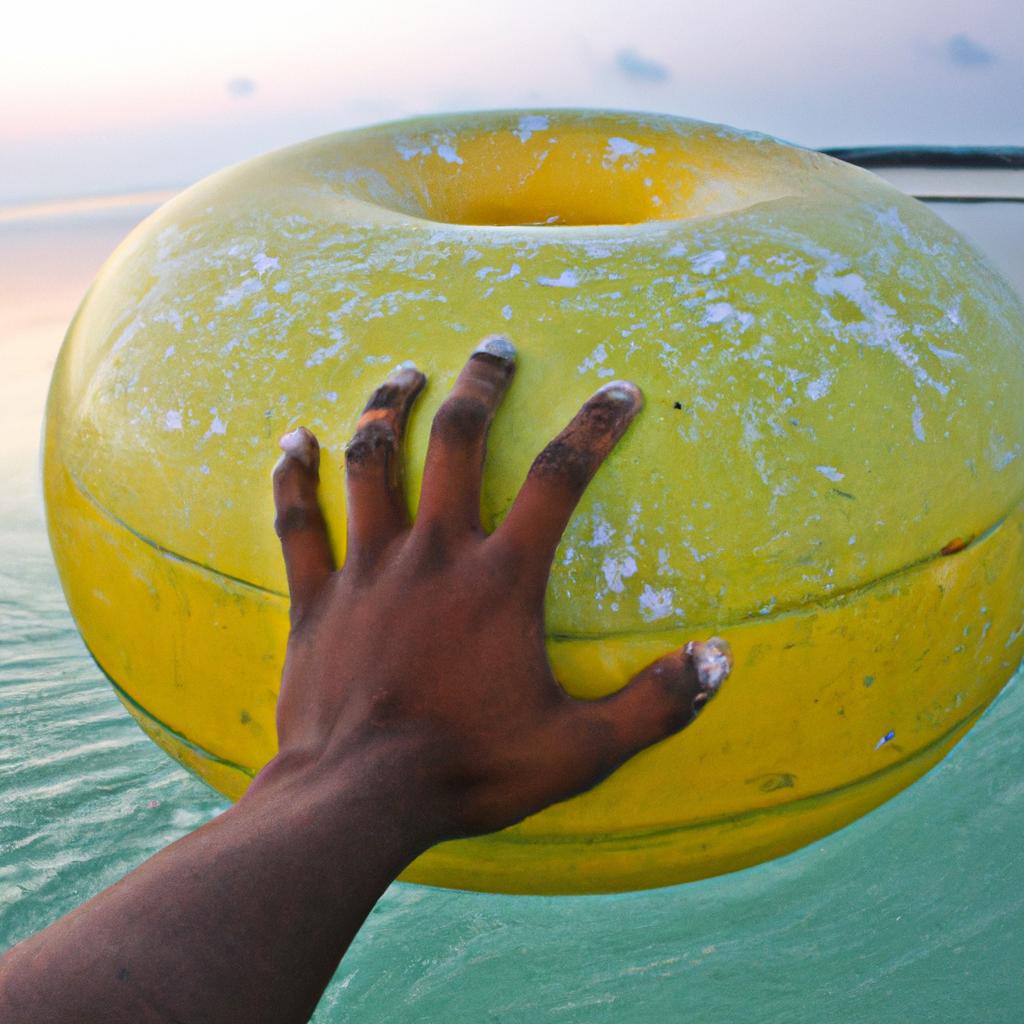Immersed Object in Floating: Archimedes Principle

The concept of immersed objects in floating is an intriguing phenomenon that can be explained by Archimedes’ principle. This principle, formulated by the ancient Greek mathematician and physicist Archimedes, states that any object partially or completely submerged in a fluid experiences an upward buoyant force equal to the weight of the displaced fluid. To illustrate this principle, consider the case of a ship sailing on water. The ship’s immense size and weight are counteracted by the buoyant force exerted by the water it displaces, allowing it to float effortlessly.
Archimedes’ principle has significant implications not only for understanding floating objects but also for various scientific fields such as hydrodynamics and marine engineering. By comprehending how immersed objects behave in different fluids, researchers can design more efficient ships, submarines, and other vessels that optimize buoyancy and minimize energy consumption. Furthermore, this principle serves as a fundamental basis for determining the density of substances through techniques like hydrometry, which finds applications in areas ranging from chemistry to geology. In this article, we will delve into Archimedes’ principle and explore its theoretical underpinnings along with practical applications in modern science and engineering disciplines.
Definition of Immersed Object
Imagine a scenario where you are relaxing in a swimming pool on a hot summer day. As you float effortlessly, you notice an interesting phenomenon: when you hold an object, such as a beach ball or even your own body, partially submerged in the water, it seems lighter than its actual weight. This intriguing observation can be explained by Archimedes’ principle and the concept of immersed objects.
An immersed object refers to any substance or material that is partly or fully submerged in a fluid medium, such as water or air. When an object is immersed, it experiences two main forces acting upon it – gravity pulling downward and buoyancy pushing upward. The net force exerted on the object determines whether it floats, sinks, or remains suspended at a certain depth within the fluid.
To better comprehend this concept, let us consider an example involving a wooden block partially immersed in water. Imagine placing a wooden block weighing 1 kg into a container filled with water. Observing closely, one can witness that although the block still weighs 1 kg out of the water, it appears to weigh less while floating in the liquid. This apparent reduction in weight occurs due to the buoyant force acting on the block.
Now let’s delve deeper into how this phenomenon works by exploring some key aspects:
- Buoyant Force: When an object is submerged in a fluid, it displaces an amount of fluid equal to its own volume. As per Archimedes’ principle, this displacement results in an upward buoyant force that opposes the gravitational force acting on the object.
- Density Difference: The reason why objects float or sink depends on their density relative to that of the surrounding fluid. If the density of an object is greater than that of the fluid, it will sink; if lesser, it will float; and if they match exactly, it will remain neutrally buoyant at any given depth.
- Magnitude of Buoyancy: The magnitude of the buoyant force is directly proportional to the volume of fluid displaced by the immersed object. Hence, larger objects or those with a greater submerged volume experience more significant upward forces compared to smaller ones.
- Equilibrium Condition: When an object achieves equilibrium in a fluid, it means that the net force acting on it becomes zero. For floating objects, this occurs when the gravitational force pulling downward equals the buoyant force pushing upward.
In summary, understanding immersed objects entails recognizing how they interact with fluids and experience buoyant forces based on their density and displacement. This knowledge provides us with valuable insights into various phenomena observed in everyday life, from floating boats and swimming pool toys to ships sailing across vast oceans.
Now, let’s explore further and delve into Archimedes’ Principle Explained, which sheds light on these fascinating concepts without delay.
Archimedes’ Principle Explained
Transitioning from the previous section, which discussed the definition of an immersed object, we will now delve into the concept of Archimedes’ principle and its application to floating objects. To illustrate this principle, let us consider a hypothetical scenario involving a ship that has been partially submerged in water.
Imagine a large cargo ship navigating through a narrow canal. As it enters the canal, the water level rises due to the displacement caused by the ship’s hull. The increase in water level is directly proportional to the volume of water displaced by the ship. This phenomenon exemplifies Archimedes’ principle, which states that when an object is immersed in a fluid, it experiences an upward buoyant force equal to the weight of the fluid it displaces.
To further understand this principle, let us explore some key aspects:
-
Buoyant Force: When an object is placed in a fluid medium such as water, it experiences an upward force known as buoyant force. This force counteracts gravity and determines whether or not an object floats.
-
Weight and Buoyancy Comparison: If an object’s weight (due to its mass) is less than or equal to its buoyant force (caused by displacing fluid), it will float. Conversely, if its weight exceeds its buoyant force, it will sink.
-
Determinants of Displacement: The amount of fluid displaced by an immersed object depends on both its shape and size. Objects with greater volume displace more fluid and experience a stronger buoyant force, thus increasing their chances of floating.
-
Density Factor: An important factor influencing flotation is density – the ratio between an object’s mass and volume. For objects with lower densities compared to that of the fluid they are placed in (e.g., wood in water), there is sufficient excess buoyant force for them to remain afloat.
To illustrate the relationship between weight, buoyant force, and density, consider the following example:
| Object | Mass (kg) | Volume (m^3) | Density (kg/m^3) |
|---|---|---|---|
| Wooden Log | 50 | 0.05 | 1000 |
| Steel Block | 100 | 0.02 | 5000 |
| Plastic Toy | 10 | 0.01 | 1000 |
In this table, we can observe how different objects with varying densities interact with their respective fluids. The wooden log has a lower density than water (1,000 kg/m³), allowing it to float due to an excess of buoyant force. Conversely, the steel block’s higher density causes it to sink as its weight exceeds the upward force exerted by the fluid. Lastly, the plastic toy also floats due to its low density in relation to water.
Understanding Archimedes’ principle and its application to floating objects provides valuable insights into various real-life scenarios such as shipbuilding and designing flotation devices. In our subsequent section on “Conditions for an Object to Float,” we will explore further factors that determine whether an object remains buoyant or sinks when immersed in a fluid medium.
Transitioning smoothly into our next topic about “Conditions for an Object to Float,” let us now examine additional considerations beyond Archimedes’ principle that influence whether an object will remain buoyant or succumb to sinking when submerged in a fluid environment.
Conditions for an Object to Float
Having explored Archimedes’ principle and its fundamental principles, let us now delve into the conditions that must be met for an object to float. To illustrate these conditions, consider a hypothetical scenario where we have a wooden block immersed in water. This example will help us grasp the concepts more effectively.
To understand why the wooden block floats, we need to consider several factors:
-
Buoyant Force: When an object is submerged in a fluid, it experiences an upward force known as buoyant force. The magnitude of this force is equal to the weight of the displaced fluid by the object. In our case study, the weight of water displaced by the wooden block creates an upward force that counteracts its own weight, allowing it to float.
-
Density Difference: For an object to float, its density should be less than or equal to the density of the fluid it is immersed in. If the density of an object is greater than that of the fluid, it will sink. Conversely, if their densities are equal, they achieve neutral buoyancy, resulting in suspension at any depth within the fluid.
-
Displacement Volume: The volume of fluid displaced by an object plays a crucial role in determining whether it floats or sinks. According to Archimedes’ principle, when an object is fully immersed in a fluid, it displaces a volume of liquid equal to its own volume. If this displacement volume exceeds or matches with the volume occupied by the entire object itself, it will float.
-
Surface Area: The surface area of an object also affects whether it can float or not. A larger surface area results in increased contact between the object and surrounding fluid molecules which leads to higher pressure exerted on top compared to bottom due to differences in height (depth). Consequently enabling easier floating rather than sinking.
By considering these factors – buoyant force, density difference, displacement volume, and surface area – we can better comprehend the conditions that allow an object to float. In our next section, we will explore how to calculate the buoyant force acting on an immersed object.
Transitioning smoothly into the subsequent section about “Calculating Buoyant Force,” let us now move forward in understanding the quantitative aspects of Archimedes’ principle.
Calculating Buoyant Force
Having discussed the conditions necessary for an object to float in the previous section, let us now delve into the concept of Archimedes’ Principle and how it relates to objects immersed in a fluid. To illustrate this further, consider the following example:
Imagine placing a metal ball on water. Initially, the ball sinks due to its density being greater than that of water. However, if we attach a buoyant material like foam to the ball, it will eventually reach a point where it displaces enough water equal to its own weight. At this stage, buoyancy becomes greater than gravity, causing the ball (with attached foam) to float.
When determining whether an object will float or sink in a fluid, several factors come into play:
- Density Differential: For an object to float, its average density must be less than that of the fluid it is placed in.
- Buoyant Force: The upward force exerted by a fluid on an immersed object determines whether it floats or not. This force is equal to the weight of the displaced fluid.
- Weight Displacement: When an object is submerged in fluid, it displaces some volume of fluid equivalent to its own weight.
- Center of Gravity and Buoyancy: The position of an object’s center of gravity relative to its center of buoyancy affects its stability while floating.
To provide visual aid and evoke emotions regarding objects floating or sinking, consider this bullet-point list:
- Objects that float effortlessly often induce feelings of awe and wonderment.
- Seeing heavy materials defy gravity through clever design evokes admiration for human ingenuity.
- Witnessing objects overcome their overwhelming mass can inspire curiosity about scientific principles at work.
- Floating objects may instill tranquility as they seem harmoniously balanced between two worlds – above and below the surface.
Additionally, here is a table illustrating common examples of objects with different densities when immersed in various fluids:
| Object | Density (g/cm^3) | Fluid | Result |
|---|---|---|---|
| Wooden block | 0.5 | Water | Floats |
| Iron nail | 7.9 | Mercury | Sinks |
| Helium balloon | -0.2 | Air | Floats |
| Oil droplet | 0.8 | Ethanol | Floats/Suspends* |
(*Note: The oil droplet may float or suspend at different levels within the ethanol, depending on its density and size.)
In understanding the principles behind floating objects, we can now move forward to explore various examples of immersed objects.
Examples of Immersed Objects
Transitioning from the previous section, let us now explore some practical applications and examples related to the concept of immersed objects and their behavior based on Archimedes’ Principle. By understanding this principle, we can gain insights into how various objects float or sink when submerged in a fluid.
To illustrate this further, consider the case of a ship floating in water. The weight of the ship exerts a downward force due to gravity. However, as long as the buoyant force acting upward is greater than or equal to the weight of the ship, it will remain afloat. This example demonstrates one of many scenarios where Archimedes’ Principle plays a crucial role in determining whether an object sinks or floats when immersed.
To delve deeper into the implications of Archimedes’ Principle, let’s examine a few key factors that influence an object’s buoyancy:
-
Density Discrepancy:
- When the density of an object is less than that of the surrounding fluid, it experiences an upward buoyant force.
- If an object has higher density than the fluid, it will tend to sink.
-
Shape and Volume:
- An object with larger volume displaces more fluid and experiences a stronger buoyant force.
- Irregularly shaped objects may displace different amounts of fluid depending on orientation, affecting their overall buoyancy.
-
Fluid Properties:
- The density and viscosity (thickness) of the fluid impact its ability to exert buoyant forces.
- Different fluids have varying densities which affect an object’s behavior when submerged within them.
-
Weight Distribution:
- Uneven distribution of weight within an object can lead to tilting or instability while floating.
By considering these factors along with Archimedes’ Principle, engineers and scientists can accurately predict the behavior of immersed objects. This understanding finds applications in fields such as naval architecture, hydrodynamics, and even everyday activities like swimming and scuba diving.
Transitioning into the subsequent section about “Applications of Archimedes’ Principle,” this knowledge serves as a foundation for exploring how this principle is utilized in various practical contexts to solve real-world problems related to buoyancy, fluid dynamics, and engineering design.
Applications of Archimedes’ Principle
Immersed Object in Floating: Archimedes’ Principle
Having discussed various examples of immersed objects, we now turn our attention to the applications of Archimedes’ principle. To delve deeper into this topic, let us consider a hypothetical scenario involving an object floating in water.
Imagine a wooden boat on a calm lake. The principles of buoyancy dictate that for the boat to float, its weight must be balanced by an upward force equal to the weight of the water displaced by the submerged portion of the boat. This concept, known as Archimedes’ principle, has practical implications beyond boats and provides insight into many real-world situations.
One such application is shipbuilding. By applying Archimedes’ principle during the design process, engineers can ensure ships are constructed with optimal buoyancy and stability. Additionally, this principle helps determine cargo capacity and load distribution on vessels, ensuring safe transportation across oceans.
To further illustrate the significance of Archimedes’ principle, consider the following bullet points:
- Diving equipment relies on this principle to enable divers to control their depth underwater.
- Submarines utilize ballast tanks filled with water or air to adjust their buoyancy and navigate through different depths.
- Hot air balloons take advantage of differences in atmospheric density based on temperature variations, allowing them to ascend or descend.
- Gasoline station storage tanks contain mechanisms that monitor fluid levels using pressure sensors based on Archimedes’ principle.
Moreover, understanding how forces act on immersing objects enables scientists and researchers to explore phenomena like gravity waves or study aquatic ecosystems more effectively. By employing mathematical models built upon Archimedes’ principle, these investigations yield invaluable insights that benefit numerous fields of study.
In summary, Archimedes’ principle finds extensive applications in various areas ranging from shipbuilding to deep-sea exploration. By comprehending how buoyant forces operate on immersed objects, engineers and scientists continue to advance our understanding of both natural and human-made systems. Embracing this principle remains crucial for further technological advancements and scientific discoveries in the future.
[Table]
| Application | Description |
|---|---|
| Shipbuilding | Optimal buoyancy, stability, cargo capacity, and load distribution on ships |
| Diving Equipment | Control of depth underwater |
| Submarines | Adjusting buoyancy to navigate through different water depths |
| Hot Air Balloons | Ascending or descending based on atmospheric density variations |
Please let me know if there is anything else I can assist you with.


